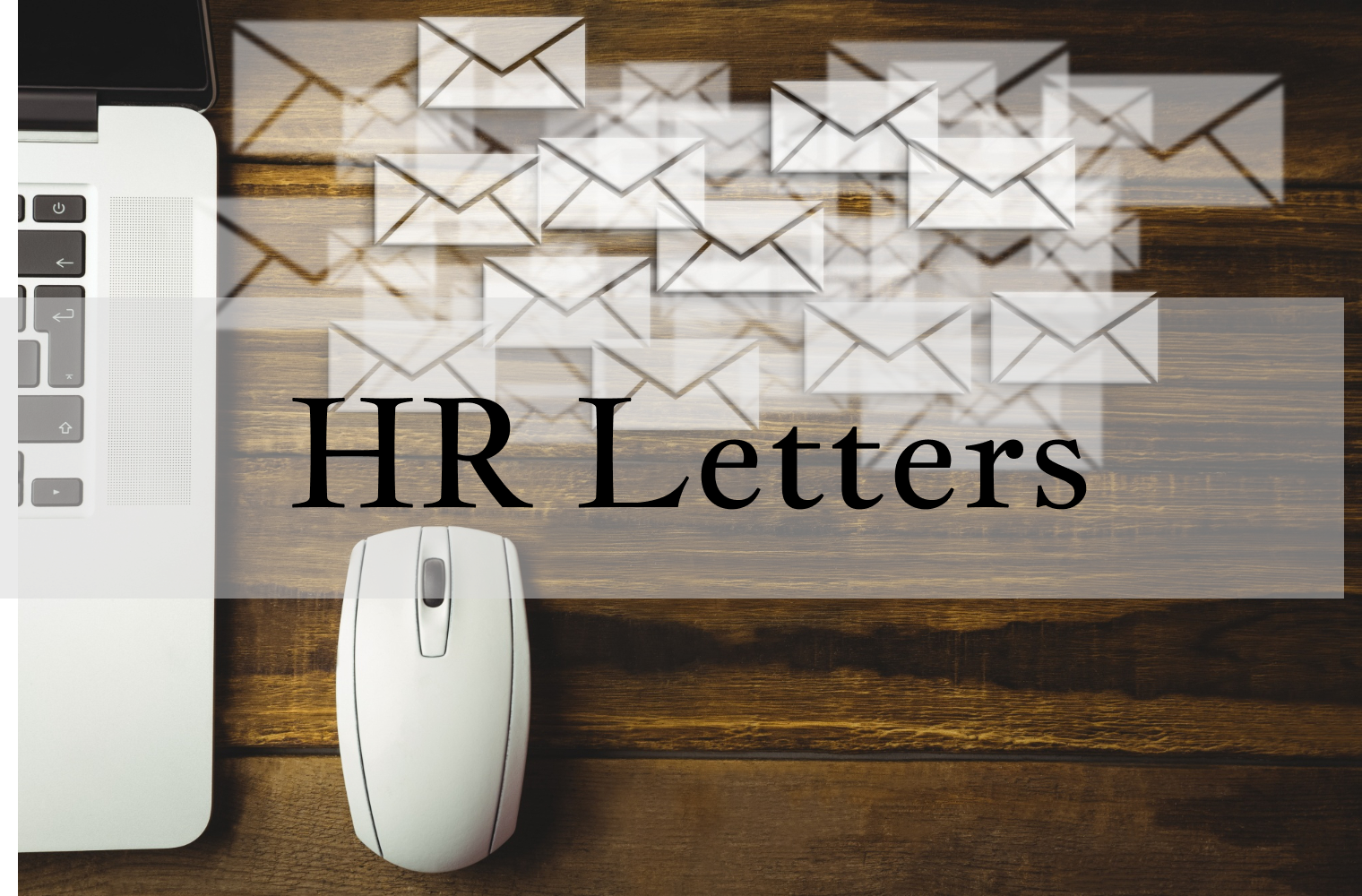Table of Contents
ToggleHuman Resources (HR) is all about communication. From hiring to saying goodbye, and managing leaves, each step involves important letters that keep things clear and professional. These letters, like job offers, rejections, performance reviews, and leave management, help businesses talk properly to their employees. Writing these letters well can make a big difference in how employees feel about the company and how the company stays out of legal trouble. This article will help you understand and write these key HR letters better, with easy tips and examples for different situations. Whether you’re hiring, praising, managing leave requests, or even letting someone go, getting your letters right is crucial for a happy and smooth-running workplace. Let’s dive into the world of HR letters and how to make them work for you.
HR letters can be grouped into various categories, each serving a distinct purpose in the employee lifecycle and organizational communication. Understanding these categories helps HR professionals manage their communications more effectively and ensures that each letter addresses its intended purpose clearly and appropriately. We’ll divide them into
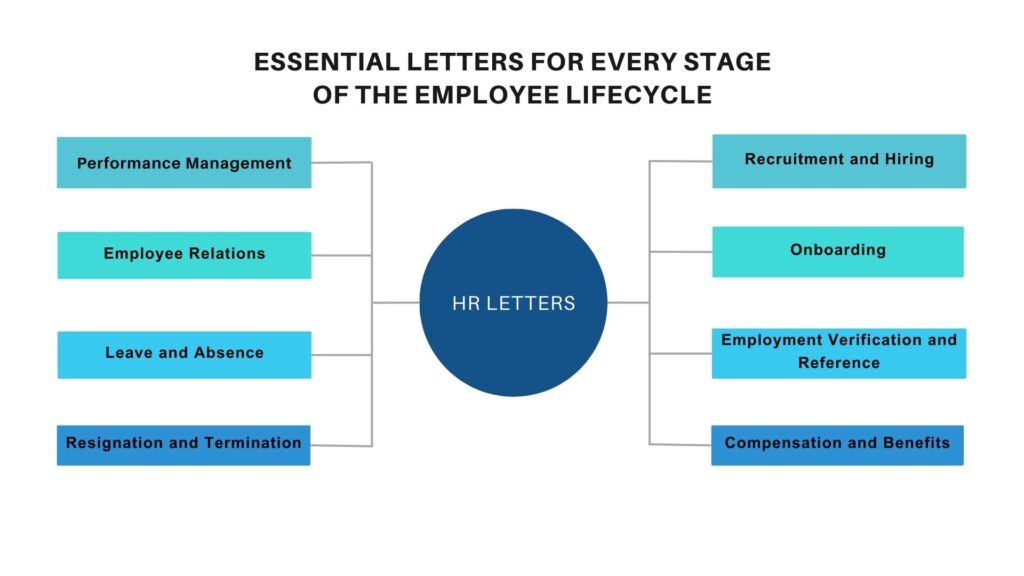
Recruitment and Hiring
Recruitment and hiring refer to the process of attracting, screening, and selecting qualified candidates for a job at an organization, aiming to fill vacancies and enhance the workforce. We’ll dive into recruiting and hiring different email categories.
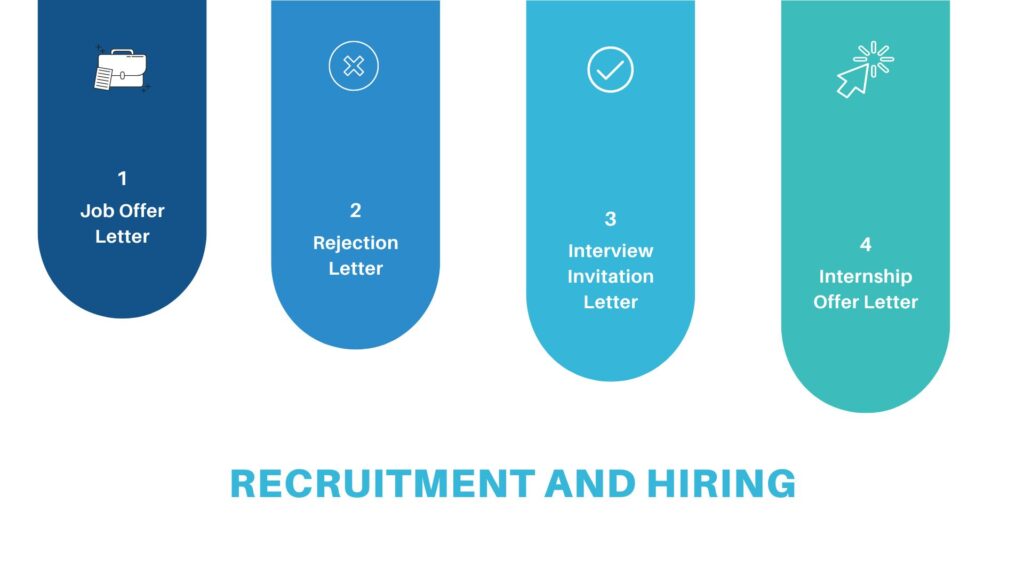
Job Offer Letter
This document details the job offer, covering position, salary, benefits, start date, and working conditions. It aims to ensure mutual understanding of the employment terms, aiding the candidate in making an informed decision. The letter is designed to be clear, concise, and comprehensive, minimizing potential misunderstandings. View this article to help you with writing professionally.
Example
Subject: Job Offer: [Position Title] at [Company Name]
Dear [Candidate’s Name],
I hope this message finds you well. On behalf of [Company Name], I am thrilled to extend to you the offer for the position of [Position Title]. Your skills and experiences stood out to us, and we are excited about the prospect of you joining our team.
Here are the details of your offer:
- Position: [Position Title]
- Start Date: [Start Date], subject to background checks and any other pre-employment requirements.
- Salary: Your starting salary will be [Salary Amount] per [year/month], payable [bi-weekly/monthly] via direct deposit.
- Benefits: You will also be eligible for [briefly mention benefits like health insurance, retirement plans, etc.], starting [Benefits Start Date].
- Work Schedule: Your standard work schedule will be [Work Hours and Days].
- Location: The position is based at our [Office Location/City], with [any remote work options if applicable].
To accept this offer, please sign and return this letter by [Acceptance Deadline]. Should you have any questions or need further clarification on any aspect of this offer, do not hesitate to reach out via email or phone at [Your Contact Information].
We at [Company Name] are confident in your abilities and look forward to welcoming you aboard. We believe that you will be a valuable addition to our team and play a key role in our continued success.
Welcome to [Company Name]!
Warm regards,
[Your Name]
[Job Title]
[Company Name]
[Contact Information]
Rejection Letter
A rejection letter is a courteous communication sent to candidates to inform them they were not chosen for a position post-interview. It should be respectful, expressing gratitude for their interest and time, while providing closure to the application process.
Example
Subject: Your Application to [Company Name]
Dear [Candidate’s Name],
Thank you for taking the time to interview for the [Position Name] with us at [Company Name]. We appreciate your interest in joining our team and the effort you put into the application process.
After careful consideration, we have decided to move forward with a candidate whose qualifications more closely align with the requirements of the role. This was a difficult decision due to the high quality of candidates this year.
We wish you all the best in your job search and future professional endeavors. Please feel free to apply for open positions with us in the future that match your skills and experience.
Thank you again for your interest in [Company Name].
Warm regards,
[Your Name]
[Position]
[Company Name]
Interview Invitation Letter
An interview invitation letter notifies a job applicant that they have been selected for an interview, outlining the specifics such as date, location, and format. It’s a formal invitation to discuss the candidate’s qualifications in more depth, offering them a chance to showcase their suitability for the role.
Example
Subject: Interview Invitation for [Position Name] at [Company Name]
Dear [Candidate’s Name],
We are pleased to inform you that your application for the [Position Name] position at [Company Name] has progressed to the next stage. We would like to invite you to an interview to further discuss your qualifications and experience.
Interview Details:
- Date: [Insert Date]
- Time: [Insert Time]
- Location: [Insert Location]
- Format: [In-person/Video Call via Platform]
- Interviewer(s): [Insert Interviewer Name(s)]
Please let us know your availability for the proposed date and time or suggest an alternative if necessary. Additional details regarding the interview format and any preparation required will be provided upon confirmation of your interview slot.
We look forward to the opportunity to speak with you. Please do not hesitate to contact us if you have any questions or need further information.
Best regards,
[Your Name]
[Position]
[Company Name]
[Contact Information]
Internship Offer Letter
An internship offer letter formalizes the offer of an internship to a candidate, detailing the role’s responsibilities, the duration of the internship, and information regarding any compensation or benefits. It serves as an agreement between the company and the intern, setting clear expectations for both parties.
Example
Subject: Internship Offer at [Company Name] for [Position/Department]
Dear [Candidate’s Name],
We are delighted to offer you the position of Intern in the [Department/Position Name] at [Company Name], starting [Start Date]. This letter outlines the terms of your internship and what you can expect from us during your time here.
Internship Details:
- Duration: The internship will start on [Start Date] and conclude on [End Date], subject to your academic schedule and performance.
- Schedule: You are expected to commit to [number] hours per week, with specific working hours to be agreed upon.
- Responsibilities: Your primary duties will include [brief description of responsibilities or projects the intern will work on].
- Compensation: [If applicable, include details about stipend, hourly wage, or any other form of compensation. If not compensated, mention any benefits like experience, learning opportunities, course credits, etc.].
- Mentorship: You will be assigned a mentor/supervisor, [Mentor’s Name], who will guide you through your projects and ensure your learning experience.
This internship aims to provide practical work experience relevant to your academic and career goals. You will have the opportunity to work on meaningful projects, enhance your skills, and contribute to our team’s success.
Please confirm your acceptance of this internship offer by [Deadline for Acceptance], by signing and returning this letter to us. We are excited about the possibility of you joining our team and look forward to your contributions.
Should you have any questions or require further clarification, please do not hesitate to contact us.
Welcome to [Company Name]!
Warm regards,
[Your Name]
[Position]
[Company Name]
[Contact Information]
Onboarding
Onboarding is the process where new employees learn about their new job and the company culture. It involves training, meeting team members, and understanding their roles and responsibilities, helping them settle in and become productive members of the team.
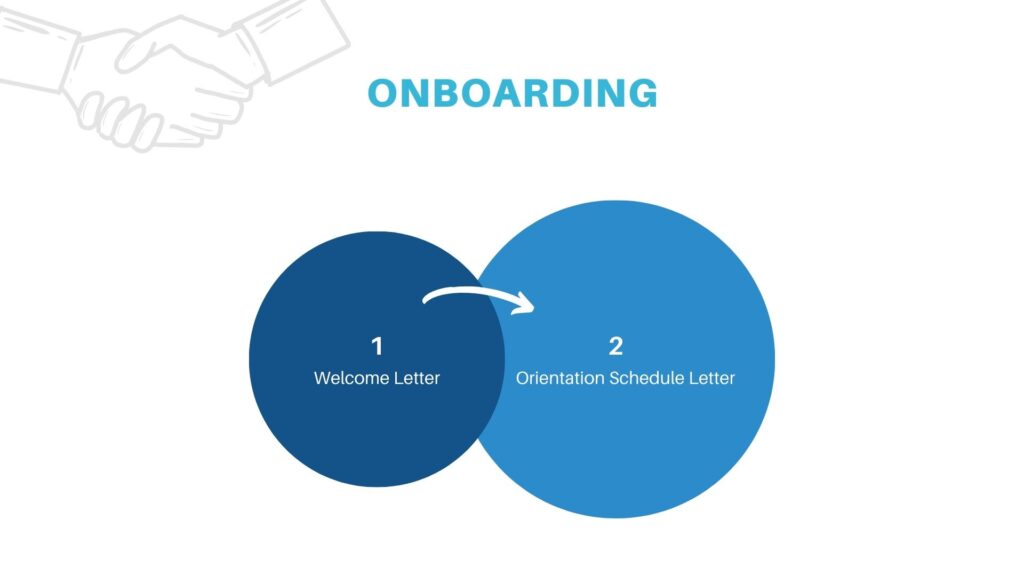
Welcome Letter
A Welcome Letter is a friendly greeting from a company to a new employee. It sets a positive tone for their employment journey, often including details about the company culture, an overview of what to expect in the first few days, and an expression of enthusiasm about the new hire’s decision to join the team.
Example
Subject: Welcome to [Company Name]!
Dear [Employee’s Name],
Welcome to [Company Name]! We are thrilled to have you join our team as [Position Name]. Your skills and talents will be a great addition to our company, and we look forward to seeing the contributions you will make.
As part of our team, you’ll find that we value collaboration, innovation, and a commitment to excellence. We believe that every team member plays a vital role in our success, and we are excited to support you in your new role.
Your first day will be on [Start Date], and we have planned an orientation session to help you get acquainted with our policies, your colleagues, and your work environment. 7
Please feel free to reach out to us with any questions or concerns you may have before your start date. We want to ensure your transition into your new role is as smooth as possible.
Welcome aboard! We can’t wait to get started.
Best wishes,
[Your Name]
[Position]
[Company Name]
[Contact Information]
Orientation Schedule Letter
An Orientation Schedule Letter provides new employees with a detailed agenda for their orientation period. It outlines the activities, sessions, and introductions planned to help them familiarize themselves with the company, its culture, policies, and their role within the organization.
Example
Subject: Welcome to [Company Name]: Orientation Day Schedule
Dear [Employee’s Name],
Congratulations once again on joining the [Company Name] team! We are looking forward to your first day with us on [Start Date], and to ensure a smooth start, we’ve arranged an orientation day tailored to help you become acquainted with our culture, team, and your new role.
Orientation Day Overview:
- Date: [Orientation Date]
- Time: Starting at [Start Time]
- Location: [Office Address/Virtual Meeting Link]
Your orientation will begin with a warm welcome from our team, Afterward, we’ll dive into the essentials: completing HR paperwork, reviewing important company policies, and discussing IT setup and security guidelines. You’ll also learn about your role in depth, including expectations, goals, and key projects you’ll be involved in.
We’ve planned a comprehensive tour of our facilities (for those joining in person) to help you find your way around, and you’ll have the opportunity to sit down with your department’s leadership for a detailed discussion about how your role fits into the broader company objectives.
The day will conclude with a Q&A session, allowing you to ask any lingering questions you might have. Throughout the day, you’ll have plenty of opportunities to ask questions and get to know more about your new work environment.
Please let us know if you have any specific dietary restrictions or other needs that we should be aware of before your arrival. Your comfort and readiness are our top priorities as we welcome you into our community.
If you need any further information or have any questions before your start date, don’t hesitate to reach out to me directly at [Your Contact Information].
Looking forward to a great start!
Warm regards,
[Your Name]
[Job Title]
[Company Name]
[Contact Information]
Employment Verification and Reference
Employment verification and reference checking mean a company looks into a job applicant’s past work history. They call past employers to confirm the jobs someone has had, their job titles, and how they performed. This helps the new company decide if the applicant is a good fit for the job.
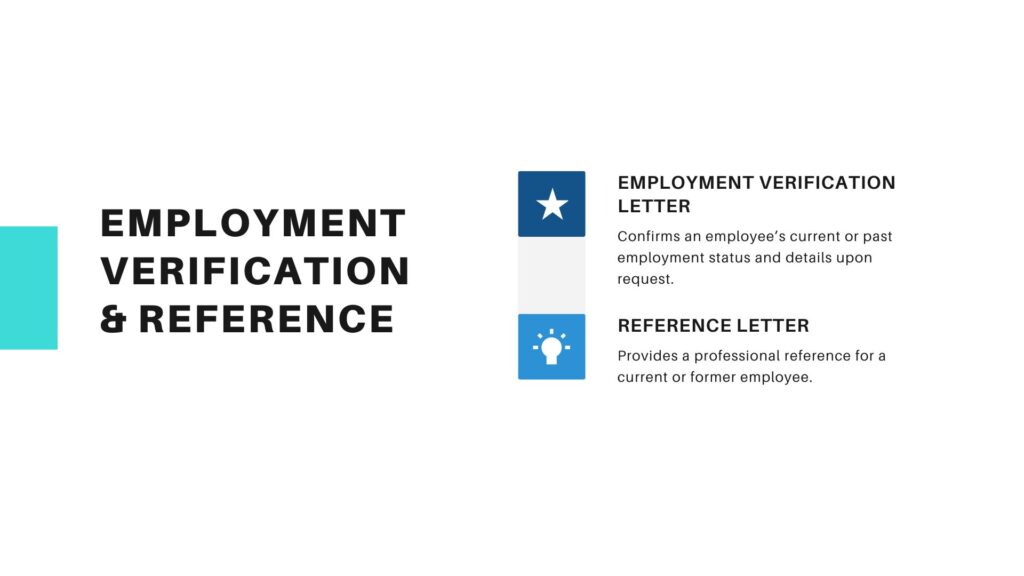
Employment Verification Letter
An Employment Verification Letter is a document provided by an employer that confirms the employment status, either current or past, of an employee. It typically includes details like the employee’s job title, the duration of their employment, and sometimes, their salary information. This letter is often requested by other employers, financial institutions, or government agencies for purposes such as new job applications, loan approvals, or immigration processes.t amet, consectetur adipiscing elit. Ut elit tellus, luctus nec ullamcorper mattis, pulvinar dapibus leo.
Example
Subject: Employment Verification for [Employee’s Name]
Dear [Requester’s Name],
This letter serves as official verification of [Employee’s Name]’s employment with [Company Name].
[Employee’s Name] has been employed with us [state if currently employed or if past employee, include employment dates] since [Start Date] [and concluded on [End Date] if no longer employed]. During their tenure, [he/she/they] held the position of [Job Title], [and include a brief description of responsibilities if necessary].
[If applicable, include salary information: “Their starting salary was [Amount] with [an annual bonus/performance incentives/etc.], and their most recent salary was [Amount].”]
Please let us know if you require any additional information or further details.
Sincerely,
[Your Name]
[Job Title]
[Company Name]
[Contact Information]
Reference Letter
A Reference Letter is a written recommendation provided by a former or current supervisor, colleague, teacher, or mentor that highlights an individual’s skills, accomplishments, and character. This letter supports the individual’s applications for new jobs, educational programs, or other opportunities by offering a personal account of their abilities and work ethic.
Example
Subject: Reference for [Candidate’s Name]
Dear [Recipient’s Name],
I highly recommend [Candidate’s Name] for [Position/Opportunity] based on my experience working with them as [Your Relationship, e.g., “their supervisor at Company Name”]. In the time I’ve known [Candidate’s Name], they have shown remarkable [mention one or two key qualities or skills, e.g., “problem-solving abilities” and “teamwork skills”].
Their contribution to [briefly describe a project or role] was invaluable, showcasing their [highlight a skill or attribute, e.g., “leadership” or “technical expertise”]. [Candidate’s Name] is also [mention a character trait, e.g., “reliable and dedicated”], making them a great fit for your team.
I’m confident [Candidate’s Name] will excel in this new role. For further details, feel free to contact me at [Your Contact Information].
Best,
[Your Name]
[Position]
[Your Contact Information]
Compensation and Benefits
Compensation and benefits are the pay and perks a job offers. Compensation includes salary and wages, how much money you make. Benefits are extra goodies like health insurance, retirement plans, and vacation time that come with the job. Together, they make up the total package that employers offer to attract and keep workers.

Salary Increase Letter
A Salary Increase Letter, from the employer’s perspective, formally announces a decision to raise an employee’s pay, recognizing their achievements and contributions. It’s a professional way to communicate appreciation and the reasons behind the salary adjustment.
Example
Subject: Salary Increase Announcement
Dear [Employee’s Name],
We’re writing to acknowledge your valuable contributions to [Company Name] as [Employee’s Position], especially your work on [mention a specific project or achievement]. In recognition of your efforts, we’re pleased to announce an increase in your salary to [New Salary Amount], effective [Effective Date].
This adjustment reflects our appreciation for your hard work and our confidence in your continued success here. Please refer to the attached document for details on your updated compensation and benefits package.
Should you have any questions, feel free to reach out to HR.
Thank you for your dedication to our team.
Best,
[Your Name]
[HR Department]
[Company Name]
[Contact Information]
Benefits Enrollment Letter
A Benefits Enrollment Letter informs employees about the available benefits they can enroll in, such as health insurance, retirement plans, and other perks. It typically includes details on the enrollment process, deadlines, and how to access further information or assistance.
Example
Subject: Open Enrollment for Company Benefits
Dear [Employee’s Name],
I hope this message finds you well. We are excited to announce the beginning of our annual benefits enrollment period, an opportunity for you to review, select, or update your benefits package for the coming year. At [Company Name], we are committed to supporting your health, well-being, and financial security through our comprehensive benefits offerings.
Enrollment Period: [Start Date] to [End Date]
How to Enroll: Access the benefits portal through [website link or instructions on how to access], where you can view detailed information about each plan, make your selections, and change your current benefits if needed.
Available Benefits Include:
- Health, Dental, and Vision Insurance
- Retirement Savings Plan (e.g., 401(k))
- Life and Disability Insurance
- Flexible Spending Accounts (FSA)
- [Other Benefits]
We strongly encourage you to take the time to carefully review all the available options and consider how they align with your and your family’s needs. If you have any questions or need assistance with the enrollment process, please don’t hesitate to contact the HR department at [Contact Information].
Remember, the choices you make now will be in effect for the next plan year, unless you experience a qualified life event that allows for changes.
Thank you for your attention to this important matter. We are here to support you in making the best decisions for your health and financial well-being.
Best regards,
[Your Name]
[Your Position, e.g., HR Manager]
[Company Name]
[Contact Information]
Performance Management
Performance management is the ongoing process of setting goals, assessing progress, and providing feedback to ensure employees meet their objectives and contribute to the organization’s success. The goal of performance management is to enhance individual and, consequently, organizational performance, fostering a culture of continuous improvement and achievement.
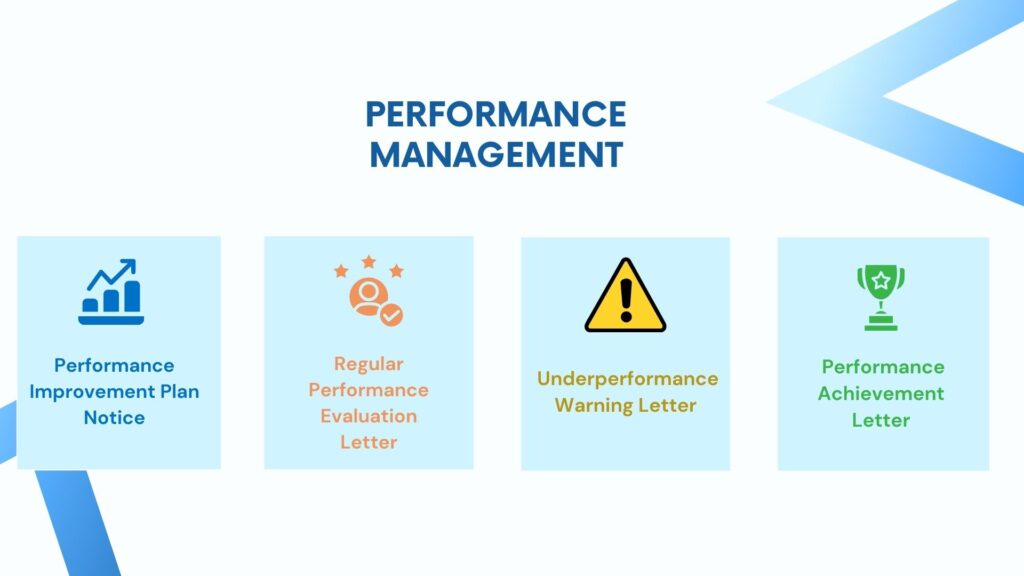
Performance Improvement Plan Notice
This is critical for employees who are struggling to meet job expectations. A PIP outlines specific areas of underperformance, sets clear, achievable goals, and provides a timeline for improvement, offering a structured path to success and accountability.
Example
Subject: Introduction to Your Performance Improvement Plan
Dear [Employee Name],
I hope you’re doing well. We’ve noticed some areas in your performance that need improvement and have prepared a Performance Improvement Plan to help you succeed at [Company Name]. This plan outlines specific goals and the support you’ll receive to meet our expectations.
Key points of the Performance Improvement Plan include:
- Areas needing improvement.
- Clear, measurable goals.
- Support and resources for you.
We’re committed to your growth and see this Performance Improvement Plan as a way to help you enhance your performance. Let’s meet on [date and time] to go over the plan and address any questions or concerns you might have.
Thank you for your commitment to improving your performance. We believe in your ability to advance and are here to support you.
Best,
[Your Name]
[Position]
[Company Name]
Regular Performance Evaluation Letter
Regular evaluations are a cornerstone of effective performance management, providing employees with feedback on their work, setting goals, and discussing career progression. This letter informs employees about upcoming evaluations, expectations, and preparation guidelines.
Example
Subject: Upcoming Performance Evaluation Meeting
Dear [Employee Name],
I hope this message finds you well. I’m writing to inform you that it’s time for your regular performance evaluation, which is scheduled for [Date]. This is an opportunity for us to discuss your accomplishments, challenges, and areas for growth over the past [period].
The performance evaluation will cover:
- A review of your goals and objectives.
- Assessment of your achievements and areas where you’ve excelled.
- Identification of any challenges and areas for improvement.
- Discussion on your future goals and potential development opportunities.
Please take some time before our meeting to reflect on your performance, considering both your successes and any areas where you feel you could improve. Feel free to prepare any questions or topics you’d like to discuss, especially regarding your career path and development within [Company Name].
Your continuous growth and development are important to us, and this evaluation is a key part of ensuring you have the support and resources you need to succeed.
Thank you for your hard work and dedication. We look forward to your insights and to planning your next steps together.
Best regards,
[Your Name]
[Position]
[Company Name]
[Contact Information]
Underperformance Warning Letter
Essential for documenting and addressing performance issues, this letter formally notifies an employee of their unsatisfactory performance, detailing the specific problems, the expected improvements, and the timeframe for showing these
Example
Subject: Notice of Performance Concerns
Dear [Employee Name],
I hope this message finds you well. As part of our ongoing commitment to employee development and success at [Company Name], we continuously monitor performance levels across our team. It has come to our attention that there are several areas of your performance that have not met the company’s expectations as outlined in [specific project, task, or performance metric].
Specifically, we have observed:
- [List specific areas of underperformance or concern].
- [Provide examples, if possible, to illustrate the concerns].
We understand that various factors can influence performance, and our goal is to support you in overcoming these challenges. To address these concerns, we would like to:
- Schedule a meeting on [date] to discuss these issues in detail.
- Develop a clear action plan for improvement, including [specific goals or milestones].
Your success is important to us, and we are committed to providing the guidance and support necessary to help you meet performance standards. We encourage you to reflect on these concerns and come prepared to discuss how we can work together to improve your performance.
We must see significant improvement in the coming [period], as continuous underperformance may lead to further disciplinary action, up to and including termination. We believe in your potential and are hopeful for a positive change moving forward.
Thank you for your immediate attention to this matter. We look forward to discussing it further and finding a productive path forward.
Best regards,
[Your Name]
[Position]
[Company Name]
Performance Achievement Letter
Recognizing and rewarding employees for outstanding performance is just as important as addressing underperformance. This letter congratulates employees on their achievements, reinforcing positive behavior and motivating them and others to continue excelling.
Example
Subject: Congratulations on Your Performance Achievements!
Dear [Employee Name],
I am thrilled to write to you today to acknowledge and celebrate your exceptional achievements over the recent period. Your hard work, dedication, and commitment to excellence have not only met but exceeded our expectations in several key areas, including [mention specific achievements or projects].
Your contributions have had a significant positive impact on our team and [Company Name] as a whole. It’s employees like you who drive our success and set a stellar example of what can be accomplished with talent and determination.
In recognition of your outstanding performance, we are pleased to [mention any reward, promotion, bonus, or simply express gratitude and appreciation]. We hope this serves as a token of our appreciation for your hard work and dedication.
We are excited to see how your continued contributions will shape the future of [Company Name]. Thank you for being such a valuable member of our team. Keep up the excellent work!
Warm regards,
[Your Name]
[Position]
[Company Name]
[Contact Information]
Employee Relations
can cover a variety of topics that are crucial to maintaining a positive, productive, and transparent relationship between the organization and its employees. These letters are tools for communication that address various situations

Conflict Resolution Letter
Communicates the outcomes of a conflict resolution process between employees or between an employee and management. It may outline agreed-upon resolutions and future expectations.
Example
Subject: Addressing Our Recent Workplace Conflict
Dear [Employee Name],
I hope this message finds you well. I’m reaching out to address the recent conflict that occurred between you and [Other Party’s Name]. We need to maintain a positive and respectful work environment, and addressing conflicts directly is a key part of that effort.
To move forward, I propose we have a meeting on [Date] to discuss this matter openly and constructively. The goal will be to understand both perspectives, identify the root causes, and agree on a resolution that respects everyone involved.
Please prepare to share your viewpoint and suggestions for how we can prevent similar issues in the future. We aim to resolve this conflict in a manner that strengthens our team and aligns with our company values.
Thank you for your cooperation and commitment to a positive workplace. I look forward to our discussion.
Best regards,
[Your Name]
[Position]
[Company Name]
Employee Recognition Letter
Acknowledges and appreciates employees for their contributions, achievements, or milestones, helping to boost morale and engagement.
Example
Subject: Well-Deserved Recognition for Your Outstanding Contribution
Dear [Employee Name],
I want to take a moment to extend my heartfelt congratulations and appreciation for your exceptional work and dedication to [Company Name]. Your efforts, especially in [specific project or achievement], have significantly contributed to our team’s success and have not gone unnoticed.
Your commitment to excellence and the positive impact you’ve made are truly valued. It’s team members like you who embody our core values and drive our company forward.
Please accept my sincere thanks for your hard work and dedication. Keep up the fantastic work!
Warm regards,
[Your Name]
[Position]
[Company Name]
Policy Change Notification Letter
Informs employees about updates or changes to company policies, ensuring they are aware of new expectations and procedures.
Example
Subject: Important Update: Policy Changes Effective [Effective Date]
Dear Team,
We’re writing to inform you of an upcoming change to our [specific policy area, e.g., “remote work policy”] that will take effect on [Effective Date]. This decision was made after careful consideration, aiming to improve our workplace and better align with our company goals.
Key Changes:
- [Briefly describe the main changes and how they will affect employees].
We understand that changes can bring questions. We encourage you to read the updated policy [attached/linked], and please don’t hesitate to reach out to [Contact Person/Department] for any clarifications or concerns.
We appreciate your adaptability and support as we implement these changes. Thank you for your continued commitment to making [Company Name] a great place to work.
Best,
[Your Name]
[Position]
[Company Name]
Employee Survey Feedback Response Letter
Addresses the collective or individual feedback received from employee surveys, outlining how the organization plans to respond to concerns or suggestions.
Example
Subject: Thank You for Your Valuable Feedback
Dear Team,
Thank you to everyone who participated in our recent employee survey. Your feedback is invaluable to us, and we’re committed to using it to make [Company Name] a better place to work.
We’ve carefully reviewed your responses and are excited to share that we will be taking the following actions based on your feedback:
- [Briefly list key actions or changes].
We believe these steps will address some of the concerns raised and help us improve our workplace together.
Your voice matters, and we’re grateful for your honest input. Please stay tuned for updates as we roll out these changes.
Thank you for helping us grow and improve.
Best regards,
[Your Name]
[Position]
[Company Name]
Leave and Absences
Leave and Absences include various scenarios where employees may need to take time off from work. HR departments typically manage and document these scenarios through specific types of letters, each catering to different circumstances. You can use Day Off Leave Tracker to manage your employees’ PTO more effectively.
Streamline your team’s vacation tracking with Day Off. Quickly set up your leave policies and approval workflows and manage your team’s leaves and absences all in one convenient location. Enjoy a seamless experience that saves you time instead of spending time sending an email to each employee concerning their request status.
Accepting Leave Requests
These letters confirm the acceptance of the employee’s leave request, whether it’s for annual leave, sick leave, maternity/paternity leave, bereavement leave, medical/disability leave, sabbatical leave, unpaid leave, emergency leave, or FMLA leave. The letter will detail the leave period, any conditions attached, and expectations during the absence. And this is your guide to writing a leave request email to your manager.
Example
Subject: Leave Request Approval
Dear [Employee Name],
I’m writing to let you know that your leave request for [dates of leave] has been approved. We’ve arranged coverage during your absence to ensure a smooth workflow.
Please ensure any ongoing tasks are handed over appropriately before your leave begins. If you have any specific instructions or need assistance with the handover, feel free to reach out.
Enjoy your time off, and we look forward to welcoming you back refreshed.
Best wishes,
[Your Name]
[Position]
[Company Name]
Rejecting Leave Requests
These communicate the decision to reject a leave request due to various reasons such as insufficient leave balance, non-compliance with leave policies, or critical business needs. The letter should explain the reasons for denial clearly and compassionately, possibly suggesting alternatives or future opportunities for leave.
Example
Subject: Leave Request Update
Dear [Employee Name],
Thank you for submitting your leave request for [dates of leave]. After reviewing our current workload and team availability, we regret to inform you that we’re unable to accommodate your request at this time.
We understand the importance of time off and did not make this decision lightly. The decision is due to [briefly mention the reason, such as a critical project deadline or peak season workload].
We encourage you to consider alternative dates, if possible, and we’ll do our best to accommodate your request then. Please let us know if you have any flexibility with your dates or if there are any pressing concerns that we should be aware of.
We appreciate your understanding and your commitment to the team’s needs during this busy period.
Best regards,
[Your Name]
[Position]
[Company Name]
Suggesting Another Date
In cases where the requested leave dates may not align with business requirements or if there’s a conflict with other employees’ leave schedules, HR might suggest alternative dates for the leave. This type of letter should provide reasons for not accommodating the original request and propose new dates, seeking the employee’s agreement.
Example
Subject: Proposal for Alternative Leave Dates
Dear [Employee Name],
Following our recent discussion regarding your leave request for [original leave dates], and considering the current workload challenges, we would like to propose alternative dates for your time off.
Understanding the importance of balancing work commitments and personal time, we’ve reviewed our team’s schedule and believe that [proposed alternative leave dates] could be a more suitable time for your absence. This period appears to align better with our project timelines and team availability.
We hope these proposed dates work for you and allow you the break you deserve without impacting our collective goals. Please let us know if these alternative dates are acceptable or if there are any other dates, you’d like us to consider.
Your flexibility and understanding are greatly appreciated as we strive to accommodate everyone’s needs while ensuring our team’s success.
Looking forward to your feedback.
Best regards,
[Your Name]
[Position]
[Company Name]
Resignation and Termination
Resignation and termination are significant aspects of the employee lifecycle that HR departments handle with sensitivity and professionalism. Communication regarding these matters often takes the form of emails or letters that formally document the change in employment status
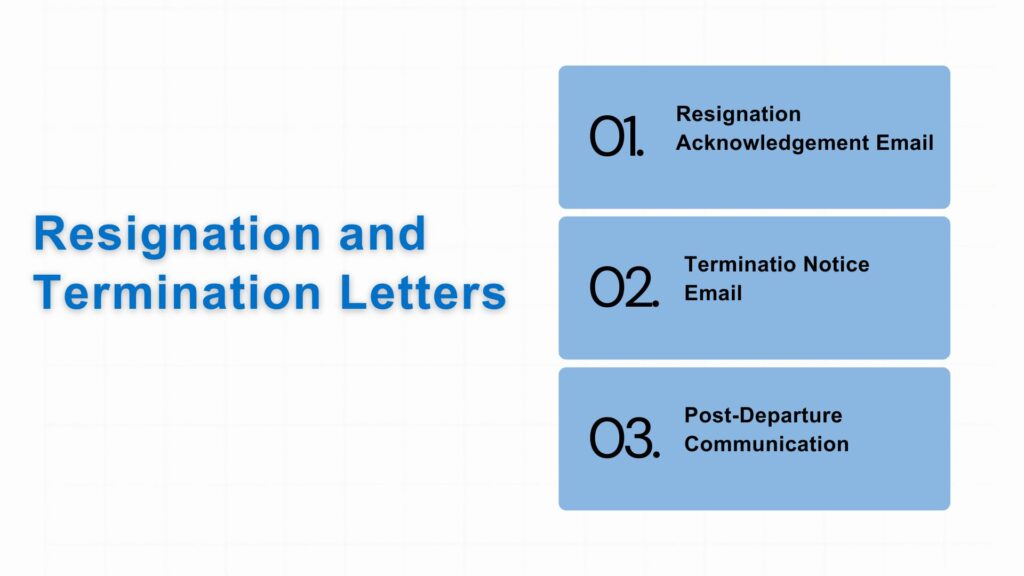
Resignation Acknowledgement Email
A Resignation Acknowledgement Email is a formal communication sent by an employer to an employee who has submitted their resignation. This email serves several purposes: it confirms that the employer has received the employee’s resignation notice, outlines the notice period according to company policy or the terms of employment, and provides an overview of the next steps in the resignation process.
Example
Subject: Acknowledgment of Your Resignation
Dear [Employee Name],
I have received and carefully reviewed your resignation letter, effective [resignation date]. While we are saddened to see you go, we respect your decision to move on and appreciate the advance notice, allowing us to prepare for a smooth transition.
Your contributions to [Company Name] have been valuable, and your presence will be missed. As we proceed, please work with your manager to ensure that all responsibilities and projects are handed over appropriately. Additionally, our HR team will reach out to you with details regarding the exit process, including final paycheck information and any benefits-related matters.
We would also appreciate your feedback on your time with us, as we continually strive to improve our work environment and employee experience.
Thank you for your hard work and dedication during your tenure here. We wish you all the best in your future endeavors and hope our paths cross again.
Best wishes,
[Your Name]
[Position]
[Company Name]
Termination Notice Email
Informs the employee of their termination, detailing reasons (if appropriate), effective date, and subsequent steps such as final paycheck and severance, if applicable.
Example
Subject: Official Termination Notice
Dear [Employee Name],
We regret to inform you that your employment with [Company Name] will be terminated effective [termination date]. This decision has been made after careful consideration and is final.
Your termination is due to [provide a brief, clear reason if appropriate and legally advised, such as “ongoing performance issues that have not improved despite repeated feedback and support” or “organizational restructuring”].
Please return all company property by your last working day. Our HR department will contact you shortly to discuss your final paycheck, benefits, and any other necessary details regarding your departure.
We understand this news is difficult. We want to thank you for your contributions during your time with us and wish you the best in your future endeavors.
Sincerely,
[Your Name]
[Position]
[Company Name]
Post-Departure Communication
Sent after the exit interview, this email thanks the departing employee for their candid feedback, reflects on their contributions, and possibly outlines any actions the company plans to take based on their suggestions or comments. This step emphasizes the value placed on each employee’s experience and aims to foster a positive, lasting relationship even after departure.
Example
Subject: Thank You for Your Valuable Feedback
Dear [Employee Name],
I wanted to personally reach out and express my gratitude for the open and honest feedback you shared during your exit interview. Your insights are invaluable to us as we continuously strive to improve our work environment and the experiences of all our employees.
Your contributions to [Company Name] have not gone unnoticed, and we truly appreciate the effort and dedication you’ve shown during your tenure. Reflecting on your feedback, we are [briefly mention any specific actions or changes the company plans to make, if applicable]. Your suggestions are instrumental in helping us move forward in a positive direction.
Though your journey with us is coming to an end, we hope to maintain a positive relationship. We wish you all the best in your future endeavors and are confident that you will continue to achieve great things. Please feel free to keep in touch.
Thank you once again for your contribution and feedback. You will always be a valued member of the [Company Name] family.
Best regards,
[Your Name]
[Position]
[Company Name]
Frequently Asked Questions (FAQ)
Why are HR letters so important?
HR letters serve as formal records of communication between employers and employees. They help clarify expectations, document decisions, and maintain professionalism across sensitive areas like hiring, promotions, disciplinary action, and leave. Well-written letters reduce misunderstandings and ensure legal compliance.
What are the most common types of HR letters?
The most frequently used HR letters include:
Job offer and rejection letters
Interview invitations
Welcome and onboarding letters
Performance evaluation and improvement notices
Leave approval and denial letters
Resignation acknowledgments and termination notices
Employment verifications and reference letters
Each type corresponds to a specific phase of the employee lifecycle.
How formal should HR letters be?
HR letters should maintain a professional tone but can vary slightly in formality based on the situation. For example, a welcome letter can be warm and conversational, while a termination notice should be direct and precise. Regardless of tone, all letters should be respectful and legally sound.
Can templates be reused for HR letters?
Yes, using templates ensures consistency and saves time. However, each letter should be customized to reflect the recipient’s name, role, and relevant circumstances. A personal touch increases clarity and shows professionalism.
How can I ensure HR letters are legally compliant?
Always consult your company’s HR policies and, when needed, labor laws applicable in your region. Avoid discriminatory language, provide accurate information, and document important actions. When dealing with terminations or disciplinary matters, it’s often wise to involve legal counsel or a senior HR advisor.
Are email formats acceptable for HR letters?
Absolutely. In most modern workplaces, email is the standard medium for sending HR letters. However, critical communications (like terminations or legal documentation) may still require a printed and signed version, or at least a PDF attached for official record-keeping.
How can I manage HR letter delivery and tracking efficiently?
Using HR platforms like Day Off or document management systems helps automate communication, maintain records, and track responses, especially useful for onboarding, performance cycles, or leave management.
What makes a good HR letter?
A well-written HR letter is:
Clear and concise
Respectful in tone
Tailored to the situation
Free of jargon or ambiguous language
Aligned with company policy and local labor laws
Action-oriented, stating next steps or expectations clearly
Conclusion
In conclusion, HR letters are crucial for clear and effective communication between a company and its employees, covering everything from hiring to resignations and terminations. These letters not only help manage important processes and document actions but also support a respectful and well-organized work environment. As workplaces evolve, the skill of crafting precise and meaningful HR letters remains vital for HR professionals, ensuring both legal compliance and positive employee relations.
